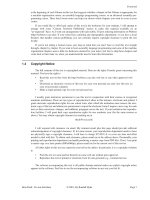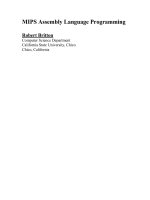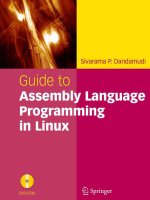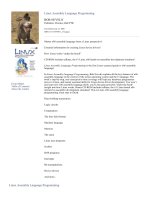6502 assembly language programming for apple, commodore, and atari computers lampton 1985
Bạn đang xem bản rút gọn của tài liệu. Xem và tải ngay bản đầy đủ của tài liệu tại đây (35.59 MB, 129 trang )
-
-,...--
6502
ASSEMBLY·
LANGUAGE
PROGRAMMING
--
-f----
I§.~
ASSEMBLY·
LANGUAGE
PROGRAMMING
far Apple,
Commodore,
and Atari
Computers
by Christopher
Lampton
A Computer Literacy Skills Book
FRANKLIN WATTS 1985
New York London Toronto Sydney
-
-, -
CONTENTS
CHAPTER ONE
The One True Language 1
CHAPTER TWO
The Microprocessor Zone 7
CHAPTER THREE
Down Memory Lane 17
CHAPTER FOUR
A 6502 Vocabulary 25
CHAPTER FIVE
Addressing Modes 45
CHAPTER SIX
Using the Assembler 57
CHAPTER SEVEN
Waving the Flags 69
CHAPTER EIGHT
Decisions, Decisions 79
CHAPTER NINE
Input and Output 87
CHAPTER TEN
Doing It All 97
APPENDIX
The 6502 Instruction Set 109
For Further Reading 113
Index 115
-
-
6502
ASSEMBLY·
LANGUAGE
PROGRAMMING
THEONE
TRUE
LANGUAGE
It may shock you to hear this, but there is only one programming language that is understood by your computer.
Oh, yes, we know that you've been told about BASIC
and FORTRAN and Pascal and Logo and any ofa number
of so-called high-level computer languages, with which one
can construct the complex lists of instructions known as
computer programs. You probably even know how to write
programs in one or more of these languages. But, truth to
tell, none ofthese languages is actually "understood" by the
computer. They are designed to be understood by human
beings. To the computer, programs written in these languages are pure gibberish.
The language that is understood by a computer is called
machine language, and it is made up of electronic signals,
as would befit the language of an electronic device. All
computer programs must be written in, or translated into,
machine language before they are acceptable to a computer.
High-level computer language-An Englishlike programming language that must be translated into machine language before it can be understood by the CPU
of a computer.
Machine language-A programming language that consists of a series of electronic signals that can be executed
directly by the CPU of a computer.
[2]
When you write a program in the language called BASIC,
for instance, it is translated into the machine language of
your computer by a second program called the BASIC
interpreter. This translation takes place while the BASIC
program is actually being executed by the computer, which
explains why BASIC programs run so slowly. A program
written in machine language will execute as much as 300
times faster than an equivalent program written in
BASIC.
This book is about machine language. More specifically, it is about an important tool that we use for writing
machine-language programs. This tool is called assembly
language. Assembly language is by far the most powerful
and flexible method available for creating computer programs. An assembly-language program can coax a computer into doing anything that it is physically equipped to do,
at the top speed of which it is capable.
If assembly language is so powerful, you might ask, why
bother with other programming languages at all? The
answer is that assembly language requires greater effort
from the programmer than high-level languages do. Developing an assembly-language program takes more time than
developing a program in a high-level language, and it
requires that the programmer keep track of a larger range of
details. Nonetheless, if you are interested in coaxing the last
ounce of power out of your computer, you may find this
extra time and effort worthwhile.
Assembly language also requires a more intimate
knowlege of the internal workings of your computer, as
opposed to high-level languages, which insulate you from
such knowledge. Thus, it requires a greater effort to learn
assembly language than to learn a high-level language.
There is so much more that you must know before you can
even begin to program in assembly language.
Interpreter-A program that translates the instructions
of the high-level language into machine language.
Assembly language-A symbolic language in which
each instruction represents a single machine-language
instruction.
[3]
In this book, we will assume from the outset that you
are already familiar with at least one high-level programming language. It doesn't matter if this language is BASIC
or Pascal or Logo or whatever, though we will occasionally
draw examples from the BASIC language to illustrate certain programming principles. What matters is that you be
familiar with the essential concepts of programmingloops, subroutines, variables, and so forth-and that you
know your way around the computer keyboard, disk drive,
cassette recorder, and so on. From that base of understanding, we will be able to take you deeper into the recesses of
the computer, where the electronic code that we call
machine language reigns supreme.
********
The key to understanding machine language is the microprocessor. This tiny chip of silicon is the core of the central
processing unit (or CPU) of a microcomputer; within it
reside thousands of interconnected transistors, too small to
be seen with a conventional microscope but capable of processing millions of electronic messages in a second. It is the
microprocessor that actually "obeys" the instructions in
our machine-language programs, turning those instructions
into actions. The microprocessor plus the internal memory-more about that in a moment-and a few other electronic chips and parts make up the CPU board of a microcomputer.
This book is concerned primarily with computers based
on a microprocessor called the 6502, and other microprocessors (such as the 6510, 6509, and 7501) in its immediate
family. These computers include the Apple II series, the
Commodore Pet, VIC, 64, and Plus 4, and the Atari 400,
800, and XL series.
A microprocessor alone does not a computer make,
Microprocessor-An integrated circuit that constitutes
the major portion of the CPU of a microcomputer.
Central processing unit (CPU)- The portion of a computer where information is manipulated as a series of
electronic signals.
[4]
however. So it will also be necessary to discuss computer
memory. Memory is actually a series of electronic circuits.
These circuits are designed in such a way that they can store
information, albeit in a coded form; they also store
machine-language programs while these programs are being
executed by the microprocessor. Most computers use two
kinds of memory: internal memory, which is immediately
available to the CPU but rather limited in the amount of
information it can store, and external memory, which is
indirectly available to the CPU (and therefore somewhat
slower to access) but of potentially unlimited size. External
memory devices include cassette recorders and disk
drives.
Furthermore, computers use two basic types of internal
memory: read-only memory (ROM) and random-access
memory (RAM). A primary difference between these two
types of memory is that the information stored in RAM can
be changed, under the control of a computer program,
while the information stored in ROM is placed there in the
factory and cannot be changed by programming. ROM is
generally used for storing the built-in programs that come
with the computer when you buy it (the BASIC interpreter,
for instance). RAM is used for storing the transient programs that you buy or store on cassette or floppy disk, or
the data that is processed by those programs.
When we combine a microprocessor with memory, we
have gone a long way toward creating a computer. Still,
there is one element that is missing. Since a computer is a
device for processing information, it is necessary to get
information into the computer, and to get it back out again
once we are finished with it. This process is called input/
output (//0, for short). It is performed by devices separate
from the microprocessor, devices that are often small computers in their own right. These devices, however, operate
Memory-A series of electronic circuits, within a computer, capable of storing information as electronic signals.
Input/output (I/O)-The movement of information between the CPU of a computer and the external world.
[5]
under the control of the CPU, waiting obediently to follow
its commands. Thus, when you program the CPU in
machine language, you indirectly program these devices.
The most popular input device on small computers is
the keyboard; the most popular output device, the video
display. Other I/O devices include disk drives (which are
also external memory storage devices), printers, "mice,"
graphics tablets, and modems.
Microprocessor, memory, and I/O-these are the elements with which the machine-language programmer is
chiefly concerned. We shall study these elements in more
detail in the chapters to come, as we plunge into the world
of assembly-language programming.
THE
MICROPROCESSOR
ZONE
It lies at the heart of your computer, an electronic circuit
among electronic circuits-but what a circuit it is! The
microprocessor is the brain of your computer, the central
hub of a network of information-processing machinery. As
much as any piece of electronic equipment is capable of
thought, the microprocessor is the part of your computer
that does the thinking.
We won't concern ourselves here with the actual physical construction of the microprocessor, the way in which
the transistors are wired and interconnected. As programmers, we need only understand those parts of the microprocessor that actually process information. These are the
parts that we can control with our machine-language programs. In this view, the most important parts of any microprocessor, including the 6502, are the registers.
What are registers? A register is an electronic circuit
capable of holding a series of electronic signals. These signals, in turn, may represent information in a coded form. A
typical register within the 6502 plicroprocessor holds either
eight or sixteen of these signals. Since each signal can take
only two possible forms-a high-voltage signal or a lowvoltage signal-we can represent these signals symbolically
Register-Memory circuit within the CPU of a computer in which information can be stored and manipulated.
[8]
as Os and 1s, with each high-voltage signal represented by a
1 and each low-voltage signal represented by a o. In fact, it
is not even necessary for us to think of the microprocessor
registers as containing electronic signals; we may imagine,
throughout the rest of this book, that they actually contain
numbers.
The contents of a typical microprocessor register, represented symbolically, might look like this:
01011110
There is a numbering system, with which you might
already be familiar, called binary. Unlike the familiar decimal numbering system, which uses ten different digits for
counting, binary only uses two digits: 0 and 1. Ifwe counted
the fingers of our two hands in binary, we would count like
this:
1,10,11,100,101 ,110,111,1000,1001 ,1010
Every number in binary has an equivalent in decimal. In
the above example, the binary number 11 is equivalent to
the decimal number 3, the binary number 111 is equivalent
to the decimal number 7, the binary number 1010 is equivalent to the decimal number 10, and so forth.
It is possible, therefore, to view the contents of a microprocessor register as a binary number. The contents of the
register shown earlier would translate into decimal as 94,
which is equivalent to the binary number 01011110. Thus,
we can also view this memory register as containing the
number 94.
There are six registers in the 6502 microprocessor, and
each has a name. They are called A, SR, X, Y, SP, and PC.
The first five-A, SR, X, Y, and SP-hold eight bits (binary
digits) apiece. Thus, each can contain any number from
Binary-A numbering system that uses two different
digits, 0 and 1.
Bit-A single digit, either 0 or 1, within a binary number; short for binary digit.
[9]
00000000 to 11111111-or 0 to 255 in decimal. Programmers have a special name for an eight-digit binary number;
they call it a byte. Each of these registers, then, can hold one
byte. The other register-PC- can hold sixteen bits, or two
bytes. Most operations that we perform with the 6502
microprocessor, however, will involve eight-digit binary
numbers. (For this reason, the 6502 is referred to as an
eight-bit microprocessor.)
In order for information to be processed by a microprocessor, it must first be translated into numbers (which represent high- and low-voltage signals). We may then request
the microprocessor to perform operations on these numbers one (or two) byte(s) at a time. As this book progresses,
we shall discuss many different ways in which we may
encode information as numbers.
What sort of operations can the microprocessor perform on these numbers? Quite a variety, actually. For
instance, we can instruct the microprocessor, in machine
language, to add a number in one register to a number
stored in the computer's memory, and to leave the sum in
one of the registers. Thus, we can use the microprocessor to
perform arithmetic. Or we can instruct the microprocessor
to move a number from one register into another, from a
register to the computer's memory, or from the computer's
memory to a register. Thus, we can use the microprocessor
to rearrange and redistribute information. Or we can even
instruct the microprocessor to manipulate the individual
bits within a single register, changing and rearranging them.
Thus, we can use the microprocessor to change one number
into another number.
The complete set of instructions that we can give to a
microprocessor, in machine language, is called the instruction set of that microprocessor. Anything that can be done
with a given computer can be done using some combination of the instructions in the instruction set of its microprocessor.
Byte-Eight bits.
Instruction set-The set of all machine-language
structions that can be executed by a given CPU.
In-
[10]
You will soon see, however, that the instructions in the
instruction set tend to be very simple-that is, they instruct
the microprocessor to perform very uncomplicated tasks,
such as moving a number from one place inside the computer to another. There are no instructions in 6502
machine language for printing a word on the screen of the
computer, or for multiplying two numbers together and
assigning the result to a variable. In fact, there are no
instructions for any number of operations that are quite
simple to specify in a high-level language. We can perform
all of these operations in machine language, of course, but
we must often combine a great many relatively simple
machine-language instructions to accomplish a single,
seemingly trivial task.
By this time, you must be curious as to what a
machine-language instruction looks like. Here, then, is an
instruction from the instruction set of the 6502 microprocessor:
10101000
This instruction tells the microprocessor to move the number stored in the A register into the Y register. You will note,
however, that this instruction is in binary. Like all other
kinds of information inside a computer, machine language
is stored as a series of binary electronic signals. This is fine
for the microprocessor, of course, for which binary is the
native language. However, it is not so fine for human programmers, who prefer to write programs in a less cumbersome, and easier to understand, form. Thus, it would be
best if we found some other method of representing
machine-language instructions.
We could, for instance, translate this instruction into
decimal, so that it would become:
168
This is certainly less cumbersome than the binary representation, but it is no easier to understand. We need yet another method of representing machine-language instructions,
so that they are easier for human beings to comprehend.
This is where assembly language comes in. Assembly
language is a symbolic method of representing machine-
[11 ]
language instructions. In assembly language, we use threeletter words called mnemonics (from a Greek word meaning "memory," because they are easy to remember) to represent machine-language instructions. Once we have written a computer program in assembly-language mnemonics,
we can use a program called an assembler to translate it into
actual binary instructions (hence the term "assembly language" ). The assembly-language mnemonic for the instruction on page lOis:
TAY
The T in this instruction stands for "transfer," the A stands
for the A register, and the Y stands for the Y register. Thus,
we can see (with a little prompting) that this instruction
means "transfer the contents of the A register to the Y register." By this same token, we can also write such assemblylanguage instructions as TAX ("transfer the contents of the A
register to the X register"), TYA ("transfer the contents of
the Y register to the A register" ), and TXA ("transfer the contents of the X register to the A register" ), each of which represents a binary instruction that performs that task. On the
other hand, we may not write TYX ("transfer the contents of
the Y register to the X register" ) or TXY (" transfer the contents of the X register to the Y register") because these
instructions, though they make logical sense, are not in the
instruction set of the 6502 microprocessor and thus have
no equivalent binary instructions.
The instructions discussed in the last paragraph are
complete within themselves-that is, the operation to be
performed and the registers on which it is to be performed
are included in the instruction. In many instances, this will
not be the case. In order for the instruction to be executed
by the microprocessor, you will need to include information in addition to that implied by the mnemonic. This
Mnemonics-Symbolic assembly-language instructions
that represent single machine-language instructions.
Assembler-A program that translates assembly-language mnemonics into machine-language instructions.
[ 12]
information is sometimes referred to as the operand of the
instruction. The operand is a value, or the location of a
value, on which the operation is to be performed. For
instance, suppose we wish to add 15 to the value stored in
the A register. We would write the assembly-language
instruction for such an operation like this:
ADC
#15
The mnemonic ADC means "add with carry." We'll explain
the "carry" part in a later chapter of this book; the "add"
should be self-explanatory. The A register is not mentioned
specifically in the instruction, but there's no need for it to
be. All arithmetic operations are performed on values in
the A register. In fact, programmers have a special name for
the A register that reflects this fact. It is called the accumulator, which is a programming term that means, roughly,
"the place where arithmetic is performed."
The number sign (#) indicates that what follows is a
number to be added to the value in A. When addition is
performed, the result of the addition is stored in the A register, where we may perform furthet machine-language
operations on it if we wish.
When this instruction is assembled-that is, translated
into machine language by the assembler-it will look like
this:
01101001 00001111
The 01101001 tells the microprocessor that addition is to be
performed on the value in the A register, and that the value
to be added will be found immediately after the instruction.
And, sure enough, 00001111 is the binary representation of
the number 15. As an assembly-language programmer, you
will rarely be aware of the actual binary representation of
Operand-The data manipulated by machine-language
instructions.
Accumulator-The register within the CPU where
arithmetic operations are performed.
[13]
the instructions you write; nonetheless, it is good to have an
idea of how we arrive at these binary representations.
In programming terms, the first byte of the instruction
(01101001, or ADC in assembly language) is called the operation code, or op-code, for short. The second (and, in some
cases, third) byte is called the operand, discussed on page
12. We will study further op-codes, their operands, and the
ways in which they are used in the succeeding chapters.
First, however, there is one more topic that must be
discussed before you embark on your career as an assembly-language programmer: the hexadecimal numbering system. You may groan at the thought of having to learn yet
another numbering system-you've already been exposed
to decimal and binary in the course of this chapter-but it
is necessary, and it will make your work as an assemblylanguage programmer much easier. Most of the numbers
used in the remainder of this book will be in hexadecimal.
Hex adecimal-or base 16, as it is sometimes calleduses sixteen different digits to represent numbers. Because
the more common decimal numbering system uses only ten
digits, it is necessary for us to borrow six digits from another source-the alphabet. The digits ofthe hexadecimal system are 0,1,2,3,4,5,6,7,8,9, A, B, C, D, E, and F. Taken by
themselves, A is equal to 10, B to 11, C to 12, D to 13, E to 14,
and F to 15. Once we have counted through F in hexadecimal, we start again at 10, then 11, 12, 13, 14, 15, 16, 17, 18,
19, 1A, 1B, 1C, 1D, 1E, 1F, 20, and so forth.
Why would we wish to count in hexadecimal, when the
more familiar decimal numbering system is readily available? Because there is a close mathematical relationship
between hexadecimal and binary that doesn't exist between
decimal and binary. This means that it's easier to translate
binary numbers into hexadecimal than into decimal. In
Operation code (op-code)-The portion of a machinelanguage instruction that specifies the type of operation
to be performed on data.
Hexadecimal (base 16)-A numbering system that uses
sixteen different digits.
[14]
fact, translations from binary to hexadecimal are surprisingly simple. Programmers can perform the necessary calculations in their heads, should this be required. The following short chart gives you all the information you will
ever need to translate binary numbers into hexadecimal
numbers:
0000-0
0001-1
0010-2
0011-3
0100-4 1000-8 1100-C
0101-5 1001-9 1101-D
0110-6 1010-A 1110-E
0111-7 1011-8 1111-F
We won't ask you to memorize this chart, though if you
continue programming in assembly language you probably
will, even if you don't make a deliberate effort to do so. The
chart shows the relationships between all four-digit binary
numbers and one-digit hexadecimal numbers: 0010 is
equivalent to 2, 1101 is equivalent to D, and so forth. The
remarkable thing about this chart, though, is that we can
use it to translate binary numbers of any length, not just
four digits. We need merely divide the binary number into
four-digit chunks, adding leading zeroes to the leftmost
chunk if it has fewer than four digits in it.
For instance, suppose we know that a register within the
6502 microprocessor contains the eight-digit binary number 01110011. How can we use the chart to translate this
into a hexadecimal number? Simple. We break the number
into two four-digit chunks: 0111 and 0011. Looking at the
chart, we see that the first chunk is equal to 7 and the second chunk is equal to 3. Thus, the binary number 01110011
is equivalent to the hexadecimal number 73. Translating
this number into decimal would be a more complicated
operation, and we will not attempt to explain how to do it
here. It is similarly easy to program the microprocessor to
perform an automatic conversion from binary to hexadecimal, should we need to print the value of a register on the
video display of the computer. We' ll see how this conversion can be programmed in a later chapter.
It is traditional, when writing programs in 6502 assembly language, to identify hexadecimal numbers by a leading
dollar sign, like this:
$5A80
[ 15]
This is the 'convention that we will follow throughout this
book. Numbers without a leading dollar sign can be
assumed to be decimal, unless stated otherwise.
Because the numbers manipulated by the 6502 microprocessor tend to be either eight bits or sixteen bits in
length, the hexadecimal numbers that we use to represent
these numbers will be either two digits or four digits in
length, with one hexadecimal digit always representing four
binary digits (and two hexadecimal digits representing a
byte).
Now that we have some idea of how information, such
as numbers and instructions, can be represented by the
assembly language programmer, let's take a look at how the
computer represents information within its own memory.









